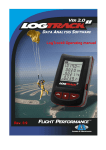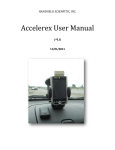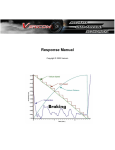Download File
Transcript
CHAPTER 5 Learning Expectations By the end of this chapter, you will: Relating Science to Technology, Society, and the Environment ● ● analyze technologies that apply Newton's laws evaluate the social and environmental impact of technologies that use the principles of force Developing Skills of Investigation and Communication ● ● ● ● Forces can change velocity. S creeching tires on the road and the crunch of metal and fibreglass being crushed — these are the typical sounds of a vehicle collision. Depending on the presence of airbags and the correct use of seat belts and headrests, motorists and passengers may avoid serious injury during a crash. In order to design these safety devices, engineers must understand what forces are and how forces affect the motion of an object. When a driver suddenly applies the brakes, the seat belts of all occupants lock. If the vehicle collides head-on with another vehicle (as simulated in Figure 5.1), airbags may become deployed. Both seat belts and airbags are designed to stop the forward motion of motorists during a head-on collision. Motorists in a stationary vehicle that is rear-ended also experience forces. The car seats move forward quickly, taking the lower part of each person’s body with it. But each person’s head stays in the same place until yanked forward by the neck. It is this sudden yank that causes whiplash. Adjustable headrests are designed to prevent whiplash by supporting the head of each motorist. analyze the forces acting on an object through inquiry and by using free-body-diagrams conduct an inquiry into the relationships among acceleration, net force, and mass analyze the relationships between accelation, frictional forces, and the coefficients of static and kinetic friction, and solve related problems using free-body diagrams plan and conduct an inquiry to analyze the effect of forces acting on objects Understanding Basic Concepts ● ● ● distinguish between different forces explain how the discoveries of Galileo and Newton advanced knowledge about forces and motion describe and apply Newton’s three laws 126 Unit B 05-PHYSICS-11SE-Ch05.indd 126 Figure 5.1 To design cars with better safety features, accident researchers use crash-test dummies to investigate the results of high-speed collisions. ©P 7/23/10 11:37:06 AM 5.1 Newton’s First Law Section Summary ● The concept of inertia explains the resistance of mass to acceleration. ● Newton’s first law extended and developed Galileo’s ideas about inertia. ● Newton’s first law can be applied in many situations. Galileo’s Insight Imagine an ideal version of the situation in Figure 5.2, in which no friction acts on the sled and no air resistance acts on the athlete. Scientist Galileo Galilei (1564–1642) thought that an object moving on a level surface would continue moving forever at constant speed and in the same direction if no external force acts on the object. If the object is initially stationary, then it will remain stationary, provided no external force acts on the object. In the everyday world, the external forces of friction and air resistance act on all moving objects. So an object that is in motion will eventually slow down to a stop, unless another force acts to compensate for both friction and air resistance. Galileo recognized the existence of these forces, so he used thought experiments, as well as experiments with controlled variables, to understand motion. Thought experiments are theoretical, idealized situations that can be imagined but cannot be created in the real world. The Concept of Inertia Since ancient times, many thinkers have attempted to understand how and why objects move. But it took thousands of years before satisfactory explanations were developed that accounted for actual observations. A major stumbling block was not identifying friction as a force that exists in the real world. In his study of motion, Galileo realized that every object has inertia. Inertia is a property that resists a change in motion such as acceleration or deceleration. From experience, you would confidently predict that it is more difficult to stop a rolling car than to stop a rolling bicycle. This means that the inertia of an object is related to its mass. The greater the mass of the object, the greater its inertia. Mass, then, is a measure of inertia. Figure 5.2 This athlete, competing in the mens’ skeleton at the Olympics, keeps air resistance and friction as low as possible so that his speed remains high. PHYSICS• SOURCE Suggested Activity ● B6 Quick Lab Overview on page 129 Newton’s First Law and Its Applications Newton modified and extended Galileo’s ideas about inertia in a law, called Newton’s first law of motion. An object will continue either being at rest or moving at constant velocity unless acted upon by an external non-zero net force. PHYSICS• SOURCE Explore More Why did Newton need to modify and extend Galileo’s ideas about inertia? In other words, an object at rest will stay at rest, and an object in uniform motion will stay in uniform motion, as long as no unbalanced force acts on it. So if you want to change the motion of an object, a non-zero net force must act on the object. ©P 05-PHYSICS-11SE-Ch05.indd 127 Chapter 5 Forces can change velocity. 127 7/23/10 11:37:07 AM Concept Check 1. Compare the inertia of an astronaut on Earth’s surface, in orbit around Earth, and in outer space. 2. Referring to the situations in Question 1, can an object ever have no inertia? Explain. Figure 5.3 The Voyager planetary missions have been extraordinarily successful in terms of number of scientific discoveries. 3. The Voyager 1 (Figure 5.3) and Voyager 2 space probes are now in interstellar space. If the speed of Voyager 1 is 17 km/s and no external force acts on the probe, describe the motion of the probe. Newton’s First Law and Sliding on Ice Many winter sports involve a person sliding on ice. In the case of the skeleton event in the Winter Olympics, an athlete uses a sled to slide along a bobsled track, as in Figure 5.4. In hockey, a player uses skates to glide across the icy surface of a rink. Suppose a person on a sled is sliding along a horizontal, icy surface. If no external force acted on the person-sled system, then according to Newton’s first law, the system would maintain the same speed and would never stop. In real life, the external forces of friction and air resistance act on all moving objects. So the system would eventually come to a stop. FN Newton’s First Law and Vehicle Safety Devices Fg Figure 5.4 Free-body diagram of a person-sled system sliding on a horizontal, frictionless surface When you are in a moving car, you can feel the effects of your own inertia. If the car accelerates forward, you feel as if your body is being pushed back against the seat, because your body resists the increase in speed. If the car turns a corner, you feel as if your body is being pushed against the door, because your body resists the change in the direction of motion. If the car stops suddenly, you feel as if your body is being pushed forward, because your body resists the decrease in speed (Figure 5.5). (a) Inertia of motorist makes (b) direction (c) Inertia of motorist makes her feel like she is being pushed backward. of motion her feel like she is being thrown forward. direction of acceleration of vehicle 5–10 cm Inertia of motorist makes her feel like she wants to continue moving in a straight line. direction of acceleration of vehicle Figure 5.5 The inertia of a motorist resists changes in the motion of a vehicle. (a) The vehicle is speeding up, (b) the vehicle is changing direction, and (c) the vehicle is stopping suddenly. Figure 5.6 The ideal position for a headrest 128 Unit B Forces 05-PHYSICS-11SE-Ch05.indd 128 When a car is rear-ended, a motorist’s body moves forward suddenly as the car seat moves forward. However, the motorist’s head resists moving forward. A properly adjusted headrest can minimize or prevent whiplash, an injury resulting from the rapid forward accelerations in a rear-end collision (Figure 5.6). Research shows that properly adjusted headrests can reduce the risk of whiplash-related injuries by as much as 40%. A poorly adjusted headrest, however, can actually worsen the effects of a rear-end collision on the neck and spine. ©P 7/23/10 11:37:07 AM When a car is involved in a head-on collision, the motorist continues to move forward. A properly worn seat belt restricts the forward motion of a motorist. If a head-on collision is violent enough, as measured by an accelerometer, sodium azide undergoes a rapid chemical reaction to produce non-toxic nitrogen gas, which inflates an airbag. The inflated airbag provides a protective cushion to increase the time over which the person decelerates. In this way, more energy is safely dissipated. The same concept applies to catching a fast-moving ball with your bare hands. Catching the ball will hurt more if you don’t move your hand backward as you catch it. PHYSICS• SOURCE Suggested Activity ● B7 Decision-Making Analysis Overview on page 129 PHYSICS• SOURCE Concept Check Take It Further Use Newton’s first law to explain why During a sudden stop, or when a motorist tries to adjust a seat belt suddenly, the seat belt locks into position. Research why seat belts lock. Write a brief report, including a diagram, of your findings. 1. Steel barriers usually separate the cab of a truck from the load 2. Trucks carrying tall loads navigate corners slowly 3. Customers who order take-out drinks are provided with lids B6 Quick Lab PHYSICS• SOURCE Challenges with Inertia Purpose Activity Overview To explore the effects of inertia This activity involves a number of challenges that depend on the inertia of small but massive objects. Prelab Questions Consider the questions below before beginning this activity. 1. Read through each challenge. What do they have in common? What makes them different? Figure 5.7 Lab materials 2. Make a prediction for what you expect to happen in each challenge. REQUIRED SKILLS B7 Decision-Making Analysis PHYSICS• SOURCE ■ ■ Gathering information Reporting results The Winter Tire Debate Issue Prelab Questions Should the Ontario Ministry of Transportation make it mandatory for drivers to have winter tires installed on their vehicles during the winter months? Consider the questions below before beginning this activity. Activity Overview You will research the design and safety data for winter tires versus other types of tires, analyze your findings, and prepare for a class debate on the issue. ©P 05-PHYSICS-11SE-Ch05.indd 129 1. What kind of evidence would convince you that winter tires should be made mandatory? 2. Why do you think that winter tires are not currently mandatory in Ontario? Chapter 5 Forces can change velocity. 129 7/23/10 11:37:09 AM 5.1 Check and Reflect Key Concept Review 1. In your own words, state Newton’s first law. 2. Give two examples, other than those in the text, that illustrate the property of inertia for both a stationary and a moving object. 3. Compare Galileo’s concept of inertia and Newton’s first law. How are they different? How are they connected? 4. Apply Newton’s first law and the concept of inertia to each of these situations. (a) How could you remove a tablecloth from under some dishes without causing the dishes to crash to the floor? Question 4(a) (b) While moving at constant speed on a level surface, a snowmobiler throws a ball vertically upward, relative to himself. If the snowmobile continues moving at constant velocity, the ball returns to the driver. Why does the ball land ahead of the driver if the snowmobile stops? Assume that the air resistance acting on the ball is negligible. 6. Why do you think it took thousands of years to correctly explain how and why objects move? Connect Your Understanding 7. Imagine you are the hockey coach for a team of 10-year-olds. At a hockey practice, you ask the players to skate across the ice along the blue line (the line closest to the net) and shoot the puck into the empty net. Most of the shots miss the net. The faster the children skate, the more they miss. Newton’s first law would help the players understand the problem, but a technical explanation might confuse them. (a) Create an explanation that would make sense to the 10-year-olds. (b) With the aid of a diagram, design a drill for the team that would help the players score in this type of situation. 8. The picture shows an astronaut trying to eat some food in a weightless environment. What would happen to the astronaut and his meal if the pilot of the spacecraft decided at that moment to turn on the spacecraft’s main engines and (a) the astronaut was facing the engines? (b) the astronaut’s back was to the engines? ⴙ y ⴙ x vby vbx vs Question 4(b) (c) If you are travelling in an airplane whose velocity is constant, you do not experience an acceleration. Explain why, if only the airplane’s speed is constant, you may experience an acceleration. 5. Riding in a car, why do you feel pushed back against your seat as you accelerate quickly down a road? 130 Unit B Forces 05-PHYSICS-11SE-Ch05.indd 130 Question 8 Reflection 9. How has your understanding of inertia changed after reading this section? 10. List three questions you have about Newton’s first law. For more questions, go to PHYSICS• SOURCE ©P 7/23/10 11:37:09 AM 5.2 Newton’s Second Law Section Summary ● Acceleration and force are proportional for an object of constant mass. ● Acceleration and mass have an inverse relationship for a constant force. ● Newton’s second law relates force, mass, and acceleration. Force, Mass, and Acceleration If a speed skater wants to win a championship race, she needs to know how to effectively apply forces to propel the body forward. World-class speed skaters such as Cindy Klassen know that maximizing the forward acceleration requires understanding the relationships among force, acceleration, and mass (Figure 5.8). Figure 5.8 Canadian Cindy Klassen won the gold medal in the 1500-m speed skating event in the 2006 Winter Olympics in Turin, Italy. Newton spent many years of his life trying to understand the motion of objects. After many experiments and a careful analysis of the ideas of Galileo, Descartes, and others, Newton eventually stated a simple mathematical relationship that models the motion of an object. This relationship, known as Newton’s second law, relates the net force acting on an object, the acceleration of the object, and its mass. It applies equally to a shot on goal in a hockey game, a car undergoing emergency braking, or the Moon as it moves around Earth in its orbit. The relationship Newton discovered, along with his law of universal gravitation, makes accurate enough predictions to steer spacecraft across the solar system. PHYSICS• SOURCE Suggested Activity ● B8 Inquiry Activity Overview on page 137 Relating Acceleration and Net Force According to Newton’s first law, an object will remain in uniform motion as long as no unbalanced force acts on it. But what happens when an unbalanced force (a non-zero net force) acts on an object? The object will accelerate in the direction of the non-zero net force. The graph in Figure 5.9 on the next page shows how an object of constant mass responds to forces acting on it. ©P 05-PHYSICS-11SE-Ch05.indd 131 Chapter 5 Forces can change velocity. 131 7/23/10 11:37:10 AM Magnitude of Acceleration (m/s2) Magnitude of Acceleration vs. Magnitude of Net Force Magnitude of Net Force (N) Figure 5.9 The net force resulting from an applied force and the force of friction acting on an object is plotted on the horizontal axis and the resultant acceleration is plotted on the vertical axis. Notice that the slope of the line is constant. The graph shows that when a non-zero net force acts on an object, the object will accelerate in that direction. The acceleration will be directly proportional to the net force as long as the mass remains constant. The relationship is a linear relationship, and can be written as a proportionality statement: a Fnet Remember that a and Fnet are vector quantities, so the statement also means they have the same direction. This relationship applies to many sports. When a soccer player kicks the ball along the ground, the horizontal forces acting on the ball are the applied push force, friction with the ground, and air resistance (Figure 5.10). As long as the applied push force is greater in magnitude than the sum of the forces of friction and air resistance acting on the ball, the net force on the ball acts forward. The harder the kick, the greater will be the forward net force on the soccer ball (Figure 5.11). So the acceleration of the ball will be greater. Note that the acceleration is in the same direction as the net force. Figure 5.10 The force applied by the soccer player to the ball is greater in magnitude than the sum of the forces of friction and air resistance acting on the ball, so the ball accelerates forward. m ⴝ constant a a Fnet Fnet Figure 5.11 For the same mass, a greater force results in a greater acceleration. Concept Check 1. What is the difference between a net force and an applied force? 2. Can a net force ever equal an applied force? Explain using an example and a freebody diagram. 3. Explain why Fnet, rather than Fapp, appears in the proportionality statement a Fnet. 132 Unit B Forces 05-PHYSICS-11SE-Ch05.indd 132 ©P 7/23/10 11:37:11 AM Relating Acceleration and Mass If you apply the same force to objects of various masses, the acceleration of each object will be different. Keeping the applied force constant in an experiment, therefore, reveals a relationship between the acceleration of an object and its mass. The more massive objects will have small accelerations, while the less massive objects would have larger accelerations. In speed skating, evidence of this relationship is the different accelerations that two athletes of different mass have. Suppose athlete A has a mass of 60 kg and athlete B a mass of 90 kg. If the net force acting on A and B is the same, you would expect A to have a greater acceleration than B (Figure 5.12). This observation makes sense in terms of inertia, because the inertia of B resists the change in motion more so than the inertia of A does. a A Suggested Activity ● B9 Inquiry Activity Overview on page 137 m Fnet constant m PHYSICS• SOURCE a B Figure 5.12 For the same net force, a more massive person has a smaller acceleration than a less massive person. 1 a _ m Acceleration vs. Mass Acceleration (m/s2) If we were to measure these accelerations, and plot acceleration versus mass for constant forces, we would obtain graphs similar to Figure 5.13. The graph shows that the relationship between acceleration and mass is non-linear. But if you plot acceleration as a function of the reciprocal of mass, you get a straight line. This shows that there is a linear relationship between acceleration and the reciprocal of mass. This relationship can be written as a proportionality statement: Mass (kg) Newton’s Second Law and Mass What happens to an object’s acceleration when the net force on it increases? when its mass increases? The proportionality statements a Fnet and Figure 5.13 Acceleration vs mass for a constant force. This relationship is non-linear. Fnet net 1 can be combined into one statement, a F _ k _ where k a _ a or m m m is the proportionality constant. Since 1 N is defined as the net force required to accelerate a 1-kg object at 1 m/s2, k is equal to 1. So the equation can be written as Fnet a _ m This mathematical relationship is Newton’s second law of motion. When an external non-zero net force acts on an object, the object accelerates in the direction of the net force. The magnitude of the acceleration is directly proportional to the magnitude of the net force and inversely proportional to the mass of the object. ©P 05-PHYSICS-11SE-Ch05.indd 133 Chapter 5 Forces can change velocity. 133 7/23/10 11:37:12 AM The equation for Newton’s second law is usually written with Fnet on the left side: Fnet ⫽ ma Concept Check 1. What happens to the acceleration of an object if (a) the mass and net force both decrease by a factor of 4? (b) the mass and net force both increase by a factor of 4? 2. What happens to the object’s acceleration if the mass increases by a factor of 4, but the net force decreases by the same factor? 3. What happens to the object’s acceleration if the mass decreases by a factor of 4, and the net force is zero? Applying Newton’s Second Law to Horizontal Motion Example 5.1 demonstrates how to use Newton’s second law to predict the acceleration of a lacrosse ball. In this situation, air resistance is assumed to be negligible to simplify the problem. Example 5.1 Practice Problems 1. The net force acting on a 6.0-kg grocery cart is 12 N [left]. Calculate the acceleration of the cart. 2. An airplane with a mass of 5.32 ⫻ 104 kg accelerates down the runway at 1.76 m/s2 [forward]. Calculate the net force acting on the airplane. 3. A net force of 34 N [forward] acts on a curling stone causing it to accelerate at 1.8 m/s2 [forward] on a frictionless icy surface. Calculate the mass of the curling stone. Answers 1. 2.0 m/s2 [left] 2. 9.36 ⫻ 104 N [forward] 3. 19 kg A lacrosse player exerts an average net horizontal force of 2.8 N [forward] on a 0.15-kg lacrosse ball while running with it in the net of his stick. Calculate the average horizontal acceleration of the ball while in contact with the lacrosse net. Given Fnet ⫽ 2.8 N [forward] m ⫽ 0.15 kg Required Average horizontal acceleration of ball (a ) Analysis and Solution The ball is not accelerating up or down. So in the vertical direction, Fnet,vertical ⫽ 0 N. Draw a free-body diagram for the system (Figure 5.14). In the horizontal direction, the acceleration of the ball is in the direction of the net force. So use the scalar form of Newton’s second law. Fnet,horiz ⫽ ma Fnet,horiz ⫽ ma Fnet a⫽_ m 2.8 N ⫽ __ 0.15 kg 2.8 kg⭈m/s2 ⫽ ___ 0.15 kg ⫽ 18.6 m/s2 Fnet Figure 5.14 Paraphrase The average horizontal acceleration of the lacrosse ball is 19 m/s2 [forward]. 134 Unit B Forces 05-PHYSICS-11SE-Ch05.indd 134 ©P 7/27/10 10:12:18 AM In Example 5.2, a free-body diagram is used to first help determine the net force acting on a canoe. Then Newton’s second law is applied to predict the average acceleration of the canoe. Example 5.2 Two athletes on a team, A and B, are practising to compete in a canoe race. Athlete A has a mass of 70 kg, athlete B a mass of 75 kg, and the canoe a mass of 20 kg. Athlete A can exert an average force of 400 N [forward] and B an average force of 420 N [forward] on the canoe using the paddles. During paddling, the magnitude of the water resistance on the canoe is 380 N. Calculate the initial acceleration of the canoe. Given mA 70 kg F 400 N [forward] mB 75 kg FB 420 N [forward] mC 20 kg Ff 380 N [backward] A Required initial acceleration of canoe (a ) Figure 5.16 Analysis and Solution The canoe and athletes are a system because they move together as a unit. Find the total mass of the system. mtotal mA mB mc 70 kg 75 kg 20 kg 165 kg Draw a free-body diagram for the system (Figure 5.15). The system is not accelerating up or down, so in the vertical direction, Fnet,vertical 0 N. Write an equation to find the net force on the system in the horizontal direction. net,horiz F B f 400 N 420 N 380 N [forward] 440 N [forward] Apply Newton’s second law to the horizontal direction. Fnet,horiz mtotala ⴙ up backward Fnet a _ mtotal ⴙ forward FN FA down 440 N __ 165 kg 440 kgm/s2 ___ 165 kg 2.66 m/s2 Paraphrase The canoe will have an initial acceleration of 2.7 m/s2 [forward]. Ff 1. In the men’s four-man bobsled event in the Winter Olympics (Figure 5.16), the maximum mass of a bobsled with pilot, two riders, and a brakeman is 630 kg. During a practice run, the rear rider and the brakeman exert average forces of 1220 N and 1200 N [forward] respectively to accelerate a bobsled of mass 255 kg, a pilot of mass 98 kg, and a forward rider of mass 97 kg (who have already gotten into the sled). Then they jump in for the challenging ride down a 1300-m course. During the pushing, the magnitude of the force of friction acting on the bobsled is 430 N. Calculate the average acceleration of the bobsled, pilot, and forward rider. 2. In a “trial of strength” contest, two contestants stand on either side of a train of three weighted train cars, and each contestant attempts to push the train toward the other one. Contestant A exerts a force of 970 N [right] while contestant B exerts a force of 1020 N [left]. If the masses of the trolleys are 125 kg, 98 kg, and 113 kg, calculate the initial acceleration of the train. F F F A Practice Problem FB Answer 1. 4.4 m/s2 [forward] 2. 0.15 m/s2 [left] Fg FA FB Figure 5.15 Ff Fnethoriz ©P 05-PHYSICS-11SE-Ch05.indd 135 Chapter 5 Forces can change velocity. 135 7/23/10 11:37:12 AM Applying Newton’s Second Law to Vertical Motion In Example 5.3, the force of gravity causes a skydiver to accelerate downward. Since the only motion under consideration is that of the skydiver and the direction of motion is down, it is convenient to choose down to be positive. Example 5.3 Practice Problems 1. A 55-kg female bungee jumper fastens one end of the cord (made of elastic material) to her ankle and the other end to a bridge. Then she jumps off the bridge. As the cord is stretching, it exerts an elastic force directed up on her. Calculate her acceleration at the instant the cord exerts an elastic force of 825 N [up] on her. 2. During a bungee jump, the velocity of the 55-kg jumper at the lowest point of her jump is zero and the cord stretches to its maximum. Compare the direction of her acceleration at the lowest point of the jump to her acceleration at the part of the jump where she is accelerating due to gravity. Answers 1. 5.2 m/s2 [up] 2. At the lowest point, her acceleration is upward, but while she is accelerating due to gravity, it is downward. PHYSICS• SOURCE Take It Further Air resistance is the frictional force that acts on all objects falling under the influence of gravity. Research how this force affects the maximum speed that an object reaches during its fall. Write a brief summary of your findings. 136 Unit B Forces 05-PHYSICS-11SE-Ch05.indd 136 A skydiver is jumping out of an airplane. During the first few seconds of one jump, the parachute is unopened, and the magnitude of the air resistance acting on the skydiver is 251 N. The acceleration of the skydiver during this time is 5.96 m/s2 [down]. Calculate the mass of the skydiver. Given Fair 251 N [up] a 5.96 m/s2 g 9.8 m/s2 [down] Ff Required mass of skydiver (m) Analysis and Solution Draw a free-body diagram for the skydiver (Figure 5.17). Fg The skydiver is not accelerating left or right. So in the horizontal direction, Fnet 0 N. For the vertical direction, write an equation to find the net force on the skydiver. Fnet Fg Ff Apply Newton’s second law. ma Fg Ff ma Fg Ff ma mg (251) 251 N mg ma 251 N m(g a) 251 N m __ (g a) 251 N ____ 9.8 m/s2 5.96 m/s2 251 kgm/s2 ___ 3.84 m/s2 65.36 kg up down ⴙ Figure 5.17 Paraphrase The mass of the skydiver is 65 kg. ©P 7/23/10 11:37:13 AM REQUIRED SKILLS DI Key Activity B8 Inquiry Activity PHYSICS• SOURCE ■ ■ Using appropriate equipment and tools Drawing conclusions Relating Acceleration and Net Force Question How is the acceleration of an object related to the net force acting on the object? Activity Overview In this activity, you will use a dynamics cart and timing equipment to measure the acceleration of a fixed mass and compare it to a range of applied forces, in this case the weights of (gravitational forces due to) standard masses. Prelab Questions Consider the questions below before beginning this activity. 1. Predict the type of relationship you will discover between acceleration and net force. 2. As you read through the procedure, identify likely sources of experimental error. Figure 5.18 Dynamics cart setup REQUIRED SKILLS B9 Inquiry Activity PHYSICS• SOURCE ■ ■ Using appropriate equipment and tools Drawing conclusions Relating Acceleration and Mass Question How is the acceleration of an object related to its mass? Activity Overview In this activity, you will use a dynamics cart and timing equipment to measure the acceleration of a range of masses, given a fixed applied force. Prelab Questions Consider the questions below before beginning this activity. 1. Predict the type of relationship you will discover between acceleration and mass. 2. As you read through the procedure, identify likely sources of experimental error. Figure 5.19 Dynamics cart setup ©P 05-PHYSICS-11SE-Ch05.indd 137 Chapter 5 Forces can change velocity. 137 7/23/10 11:37:13 AM 5.2 Check and Reflect Key Concept Review 1. In your own words, state Newton’s second law. 2. An applied force Fapp acting on an object of constant mass causes the object to accelerate. Sketch graphs to show the relationship between a and Fapp when friction is (a) present, and (b) absent. 3. Sketch a graph to show the relationship between the magnitude of acceleration and mass for constant net force. 4. Explain why vehicles with more powerful engines are able to accelerate faster. 5. Pick a sports or other situation that involves Newton’s second law, and explain how Newton’s second law applies to that situation. 6. Summarize concepts and ideas associated with Newton’s second law using a graphic organizer of your choice. Make sure that the concepts and ideas are clearly presented and are linked appropriately. Connect Your Understanding 9. A piece of lead on a table, initially at rest, has a force of 195 N [right] exerted on it. If the force of friction is 155 N and the resultant acceleration is 2.5 m/s2 [right], determine the mass of the piece of lead. 10. A student applies a force of 125 N [left] on a 12.5-kg block of wood, which is initially at rest. Another student also applies a force of 32 N [left] on the block. If the block accelerates at 3.7 m/s2 [left], calculate the frictional force involved with this motion. 11. Two boxes, A and B, are touching each other and are at rest on a horizontal, frictionless surface. Box A has a mass of 25 kg and box B a mass of 15 kg. A person applies a force of 30 N [right] on box A which, in turn, pushes on box B. Calculate the acceleration of the boxes. 12. A 2.9-kg bucket is lifted upward with a force of 46 N against the force of gravity. Calculate its upward acceleration, ignoring all frictional forces. 13. A 78-kg parachutist, in the first few seconds of her jump, accelerates at a rate of 7.4 m/s2 [down]. Calculate the force she experiences due to air resistance. 7. A dolphin experiences a force of 320 N [up] when it jumps out of the water. The acceleration of the dolphin is 2.6 m/s2 [up]. (a) Calculate the mass of the dolphin. (b) What would be the acceleration of the dolphin if it had the same strength but half the mass? 14. Many hockey players like to practice with a heavy practice puck. (a) State two advantages that practicing with a weighted practice puck would provide to a hockey player. (b) How would the acceleration of a regular puck compare to that of a weighted puck if hit with the same force? 8. An ice hut used for winter fishing is at rest on a level patch of snow. The mass of the hut is 80 kg. A wind exerts a horizontal force of 205 N [E] on the hut, and causes it to accelerate. While in motion, the magnitude of the force of friction acting on the hut is 196 N [W]. (a) Draw a free-body diagram of the hut. (b) What is the acceleration of the hut? 15. Consider a spacecraft whose engines cause it to accelerate at 5.0 m/s2. (a) What would be the spacecraft’s acceleration at a later time if half its fuel has been used up? (b) What assumptions have you made in order to answer (a)? If the ice hut now accelerates at 0.95 m/s2 [E], calculate (c) the net force acting on the hut, and (d) the force applied by the wind if the force of friction remains at 196 N. Reflection 16. How did your understanding of the relationships among net force, mass, and acceleration change after working through this section? For more questions, go to 138 Unit B Forces 05-PHYSICS-11SE-Ch05.indd 138 PHYSICS• SOURCE ©P 7/23/10 11:37:19 AM 5.3 Newton’s Third Law Section Summary ● Forces always occur in pairs. ● Newton’s third law describes how forces always exist in action-reaction pairs. Forces Always Exist in Pairs Volleyball is a sport that involves teamwork and players knowing how to apply forces to the ball to redirect it. When the velocity of the ball is large, a player will usually “bump” the ball to slow it down so that another player can redirect it over the net (Figure 5.20). At the instant the player bumps the ball, the ball exerts a large force on the player’s arms, often causing soreness. Immediately after the interaction, the ball bounces upward. To explain the motion of each object during and after this interaction requires an understanding of Newton’s third law. Newton’s first two laws describe the motion of an object or a system of objects in isolation. But to describe the motion of objects that are interacting, it is important to examine how the force exerted by one object on another results in a change of shape and/or motion for both objects. When two objects interact, two forces will always be involved. These forces are the action force and the reaction force. The action force is the force on the first object and the reaction force is the force exerted by the first object on the second. Two important points to remember are that the reaction force always acts on a different object than the action force, and that the reaction force acts in the opposite direction. Figure 5.20 In vollleyball, “bumping” the ball slows it down so that another player can make the shot. Newton’s Third Law and Its Applications Newton found that the reaction force is equal in magnitude to the action force, but opposite in direction. This relationship is called Newton’s third law of motion. If object A exerts a force on object B, then B exerts a force on A that is equal in magnitude and opposite in direction. PHYSICS• SOURCE Explore More What are the implications of Newton’s third law for vehicle collisions? FA on B FB on A Some people state Newton’s third law as “for every action force, there is an equal and opposite reaction force.” However, remembering Newton’s third law this way does not emphasize that the action and reaction forces are acting Faction on different objects (Figure 5.21). force exerted by student on ground ©P 05-PHYSICS-11SE-Ch05.indd 139 Freaction force exerted by ground on student Figure 5.21 The action force is the backward force that the student exerts on the ground. The reaction force is the forward force that the ground exerts on the student. Only the action-reaction pair are shown here for simplicity. Chapter 5 Forces can change velocity. 139 7/23/10 11:37:19 AM Action-Reaction Forces Acting on Objects in Contact F action force exerted by player on ball force exerted by ball on player F reaction Figure 5.22 The action-reaction forces at collision time PHYSICS INSIGHT In order to show pairs of actionreaction forces, you must draw two free-body diagrams, one for each object. Action-reaction pairs are never drawn on the same free-body diagram because they act on different objects. PHYSICS• SOURCE Suggested Activity ● B10 Quick Lab Overview on page 142 Let’s revisit the scenario of the volleyball player bumping the ball. At the instant that both the ball and the player’s arms are in contact, the action force is the upward force that the player exerts on the ball. The reaction force is the downward force that the ball exerts on the player’s arms. During the collision, the ball accelerates upward and the player’s arms accelerate downward (Figure 5.22). A similar reasoning applies when a baseball bat strikes a baseball. The action force is the forward force that the bat exerts on the ball. The reaction force is the backward force that the ball exerts on the bat. During the collision, the ball accelerates forward and the bat slows down as it accelerates backward. Sometimes an object can exert a force on another without actually touching the other object — an at-a-distance force, as opposed to contact forces, such as frictional forces. This situation occurs, for example, when an object falls toward Earth’s surface. Action-reaction forces still exist in these interactions. When an apple falls toward the ground, the action force is the gravitational force that Earth exerts on the apple. The falling apple, in turn, exerts a reaction force upward on Earth. force exerted by So while the apple is accelerating down, Earth Faction Earth on apple is accelerating up (Figure 5.23). You see the acceleration of the apple but not of Earth because the mass of the apple is far less than that of Earth. In fact, Earth does accelerate but at a negligible rate because the magnitude of the acceleration is inversely force exerted by proportional to mass. F apple on Earth reaction Figure 5.23 The action-reaction forces when an apple falls toward Earth’s surface Concept Check 1. Is it possible to have an action force without a reaction force? Explain. 2. If the action force is equal in magnitude to the reaction force, how can there ever be an acceleration? Explain using an example and free-body diagrams. 3. Compare action-reaction pairs for a) contact forces and b) action-at-a-distance forces. How are they alike, and how are they different? Applying Newton’s Third Law In Example 5.4, an applied force acts on box A, causing all three boxes to accelerate. Newton’s third law is used to calculate the force that box C exerts on box B. 140 Unit B Forces 05-PHYSICS-11SE-Ch05.indd 140 ©P 7/23/10 11:37:20 AM Example 5.4 Three boxes, A, B, and C, are positioned next to each other on a horizontal, frictionless surface (Figure 5.24). An applied force acting on box A causes all the boxes to accelerate at 1.5 m/s2 [right]. Calculate the force exerted by box C on box B. Given mA 8.0 kg mB 10 kg mC 5.0 kg a 1.5 m/s2 [right] 8.0 kg 10 kg 5.0 kg C Figure 5.24 Required force exerted by box C on box B (FC on B) Analysis and Solution Draw a free-body diagram for box C (Figure 5.25). Write equations to find the net force on box C in the horizontal direction. Fnet,horiz FB on C Fnet,horiz FB on C FN Apply Newton’s second law. FB on C mca (5.0 kg)(1.5 m/s2) 7.5 kgm/s2 7.5 N FB on C 7.5 N [right] ⴙ up left down Apply Newton’s third law. C on B F 1. For the situation in Example 5.4, calculate the force that box B exerts on box A. 2. A passenger in a boat approaching a dock attempts to step onto the dock before the boat has been tied up. The passenger, whose mass is 57 kg, accelerates at a rate of 3.2 m/s2 [forward] relative to the boat. If the mass of the boat is 97 kg, what is the boat’s acceleration relative to the passenger? Neglect the horizontal force of the water on the boat. B A Practice Problems ⴙ right 3. What is the net acceleration of the passenger in Question 2 (relative to the dock)? Is the passenger likely to fall in? Explain. Answers 1. 23 N [left] 2. 1.9 m/s2 [backward] F 7.5 N [left] B on C 3. 1.3 m/s2 [forward] ; no, because his net acceleration is still forward. Paraphrase The force exerted by box C on box B is 7.5 N [left]. FB on C mC Fg Figure 5.25 ©P 05-PHYSICS-11SE-Ch05.indd 141 Chapter 5 Forces can change velocity. 141 7/23/10 11:37:20 AM PHYSICS• SOURCE Explore More What role do Newton’s second and third laws play in the acceleration of jet-powered aircraft? Applying Newton’s Second and Third Laws to Propeller Aircraft The acceleration of many devices, such as propeller aircraft, can be controlled in midair. To explain how these machines accelerate involves applying Newton’s second and third laws. A propeller airplane can move through air because as the propeller rotates, it exerts an action force on the air, pushing the air backward. According to Newton’s third law, the air, in turn, exerts a reaction force on the propeller, pushing the airplane forward. Propeller blades are slanted so that they scoop new air molecules during each revolution. The faster a propeller turns, the greater is the mass of air accelerated backward, and the greater is the acceleration of this mass. By Newton’s second law, the force exerted by the air on the propeller increases. Applying Newton’s Third Law to Rockets PHYSICS• SOURCE Take It Further Explore how Newton’s third law affects how astronauts live, interact, and do maintenance on the International Space Station. Prepare a written paper, a presentation, or another method of your choosing to detail your findings. Figure 5.26 The action-reaction forces when a rocket is in flight B10 The motion of rockets is a little different from that of propeller airplanes because a rocket does not have propellers that scoop air molecules. In fact, a rocket can accelerate in outer space where there is a vacuum. When a rocket engine is engaged, the highly combustible fuel burns at a tremendous rate. The action force of the exhaust gas leaving the rocket, according to Newton’s third law, causes a reaction force that pushes against the rocket. It is the action force of the exhaust gas being directed backward that accelerates the rocket forward (Figure 5.26). That is why a rocket can accelerate in outer space. Faction Freaction force exerted by rocket on exhaust gas force exerted by exhaust gas on rocket Quick Lab PHYSICS• SOURCE Exploding Carts Purpose Prelab Questions To determine the motion of two identical stationary carts after one cart exerts a net force on the other Consider the questions below before beginning this activity. Activity Overview 1. Predict what will happen to the cart when the spring is released without touching the other cart. You will use a spring on a stationary dynamics cart to have it exert a net force on another such cart, and then observe and analyze the results. 2. Is it possible for the other cart not to move? Figure 5.27 Lab setup 142 Unit B Forces 05-PHYSICS-11SE-Ch05.indd 142 ©P 7/23/10 11:37:20 AM 5.3 Check and Reflect Key Concept Review 1. In your own words, state Newton’s third law. 2. Explain why (a) a swimmer at the edge of a pool pushes backward on the wall in order to move forward, and (b) when a person in a canoe throws a package onto the shore, the canoe moves away from shore. 3. No matter how powerful a car engine is, a car cannot accelerate on an icy surface. Use Newton’s third law to explain why. 4. State and sketch the action-reaction forces in each situation. (a) The wind pushes sideways with a force of 600 N on the sail of a boat. (b) An object hanging at the end of a spring exerts a force of 30 N [down] on the spring. Connect Your Understanding 5. An object is resting on a level table. Are the normal force and the gravitational force acting on the object a pair of action and reaction forces? Explain your reasoning. 6. Suppose you apply a force of 10 N to one spring scale in the setup shown. What is the reading on the other spring scale? What is the force exerted by the anchored spring scale on the wall? F? Y X Fapp Question 8 (a) Calculate the action-reaction forces the blocks exert on each other. (b) Suppose the magnitudes of the force of friction on blocks X and Y are 8.0 N and 4.0 N respectively. Calculate the actionreaction forces the blocks exert on each other. 9. If you spike a volleyball why does your hand hurt? Which force causes the pain? 10. Consider an apple falling toward Earth. As the apple falls, the action force is the gravitational force that Earth exerts on the apple, and the reaction force is the apple pulling upward on Earth. Is it possible to measure Earth’s acceleration toward the apple? If so, which quantities would you need to measure, and what would this acceleration be? 11. Answer the following questions, explaining how your study of Newton’s third law in this section has helped you answer them. (a) Predict the function of the small openings found on the nose of the spacecraft below. (Hint: The pilot can fire jets of gas out of these openings.) (b) Predict other possible locations on the spacecraft for openings like these. 10 N Question 6 7. A vehicle pushes a car of lesser mass from rest, causing the car to accelerate on a rough dirt road. Sketch all the action-reaction forces in this situation. 8. Blocks X and Y are attached to each other by a light rope and can slide along a horizontal, frictionless surface. Block X has a mass of 10 kg and block Y a mass of 5.0 kg. An applied force of 36 N [right] acts on block X. ©P 05-PHYSICS-11SE-Ch05.indd 143 Question 11 Reflection 12. How did your understanding of how two objects exert forces on each other change after studying Newton’s third law? For more questions, go to PHYSICS• SOURCE Chapter 5 Forces can change velocity. 143 7/23/10 11:37:21 AM 5.4 Friction Affects Motion Section Summary ● Static and kinetic friction affect the motion of an object. ● There are applications of friction in transportation, sports, anatomy, and many other areas. ● Magnitudes of kinetic friction forces are proportional to the normal forces involved. ● Coefficients of friction are used to calculate magnitudes of kinetic friction forces. The Nature of Friction Friction is a force that is present in almost all real-life situations. It acts parallel to the common surface between two objects, resisting motion between them. In some cases, friction is desirable while in other cases, Explore More friction reduces the effectiveness of mechanical systems. What factors affect the ability of a Without friction, you would not be able to walk. The wheels on a loonie to start sliding? How could you investigate this question? vehicle would have no traction on a road surface and the vehicle would not be able to move forward or backward. Parachutists would not be able to land safely. On the other hand, friction causes mechanical parts to seize and wear out and mechanical energy to be converted to heat. For example, snowmobiles cannot move for long distances over bare ice. Instead, snowmobilers must detour periodically through snow to cool the moving parts not in contact with the ice. To determine the direction of the force of friction acting on an object at rest, you need to first imagine the direction in which the object would move if there were no friction. The force of friction, then, opposes motion in that direction. In a sport such as curling, friction affects how far a moving stone will travel along the ice. Sweeping the ice in front of a moving stone reduces the force of friction acting on the stone (Figure 5.28). The result is that the stone slides farther. If you drag an object on a smooth surface, the force of friction acting on the object is less than if you drag it on a rough or bumpy surface. If you drag a smooth block and a rough block on the same surface, the force of friction acting on each block will be different. The force of friction depends, in part, on the nature of the two surfaces in contact — some surfaces tend to produce smaller frictional forces than others. Although there are different types of friction, the force of Figure 5.28 Friction and its reduction play an important role in many winter sports, such as curling. friction that acts on objects sliding across another surface is the main focus in this section. PHYSICS• SOURCE 144 Unit B Forces 05-PHYSICS-11SE-Ch05.indd 144 ©P 7/23/10 11:37:22 AM Static Friction Static friction, Ff,static, is the force that prevents an object at rest from starting to move. An important point about static friction is that its magnitude does not have a fixed value. Instead, it varies from zero to some maximum value. This maximum value is reached at the instant the object starts to move. If you push on a table with a force of steadily increasing magnitude, you will notice that the table remains at rest until you exceed a critical value. Because of Newton’s second law, the magnitude of the force of static friction must increase as the applied force on the table increases, if the forces are to remain balanced. The amount of force that must be applied to the object in order to start it moving is known as static friction. Kinetic Friction Suppose you apply a force to a desk and the desk starts to slide across the floor at constant velocity. In this situation, the force of static friction is not able to balance the applied force, so motion occurs. Now the floor will exert a force of kinetic friction, Ff,kinetic, on the desk that opposes the direction of motion of the desk. The force of kinetic friction is present any time an object is sliding on another, whether or not another force acts on the sliding object. If you stop pushing the desk once it is in motion, the desk will coast and eventually stop. While the desk is sliding, the floor exerts a force of kinetic friction on the desk. This frictional force is directed backward, and causes the desk to eventually come to a stop. Comparing the Magnitudes of Static and Kinetic Friction The magnitude of the force of kinetic friction is never greater than the maximum magnitude of the force of static friction. Often, the magnitude of Ff,kinetic is less than the magnitude of Ff,static. Figure 5.29 shows a graph of a situation where a person is applying very little force to an object during the first 2 s. Then the person begins to push harder, and at t 4 s, the object starts to move. The graph does not provide any information about the applied force after 4 s. Magnitude of the Force of Friction vs. Time Magnitude of the force of friction Ff (N) static friction maximum value of static friction kinetic friction 2 1 0 4 8 12 Time t (s) 16 20 Figure 5.29 The force of static friction increases up to a maximum value. The force of kinetic friction is approximately constant. ©P 05-PHYSICS-11SE-Ch05.indd 145 Chapter 5 Forces can change velocity. 145 7/23/10 11:37:23 AM Concept Check 1. Explain why it makes sense that the magnitude of the force of kinetic friction does not exceed the maximum magnitude of the force of static friction. 2. How does static friction compare in magnitude to the applied force it opposes? 3. How does kinetic friction compare in magnitude to the applied force it opposes? Explain your answer. PHYSICS• SOURCE Explore More Leonardo da Vinci was as creative in science as he was in art. What were some of da Vinci’s scientific ideas? Determining the Magnitude of Frictional Forces Leonardo da Vinci (1452–1519) was one of the first people to experimentally determine two important relationships about friction. He discovered that the force of kinetic friction acting on an object depends on the normal force acting on that object. Da Vinci also discovered that for hard contact surfaces, the force of friction does not depend on the area of contact. Changing the surface area of flat objects will cause them to exert different amounts of pressure on the contact surface. A larger surface area will exert less pressure than a smaller surface area. The normal force on horizontal objects will always remain the same since the weight hasn’t changed. So an increase in surface area is cancelled out by a reduction in pressure. In order for this to hold true, the mass of the object must be evenly distributed. This means that if you push a heavy box across the floor, the force of friction acting on the box is the same whether you slide it on its bottom or on its side (Figure 5.30). Coefficient of Static Friction The maximum magnitude of the force of static friction is directly proportional to the magnitude of the normal force. This proportionality can be written mathematically: (Ff,static)max FN As an equation, the relationship is Figure 5.30 The force of friction acting on these two boxes as they move is the same. The force of friction does not depend on surface area. PHYSICS• SOURCE (Ff,static)max µsFN where µs is a proportionality constant called the coefficient of static friction. Since Ff,static can be anywhere from zero to some maximum value just before motion occurs, the general equation for the magnitude of the force of static friction must have an inequality sign. Ff,static µsFN for static friction Suggested Activity ● B11 Inquiry Activity Overview on page 151 Coefficient of Kinetic Friction The magnitude of kinetic friction is directly proportional to the magnitude of the normal force. This proportionality can be written mathematically: Ff,kinetic FN 146 Unit B Forces 05-PHYSICS-11SE-Ch05.indd 146 ©P 7/23/10 11:37:23 AM A constant must be added in order to make an equation from this relationship: PHYSICS• SOURCE Suggested Activity Ff,kinetic µkFN ● where µk is a proportionality constant called the coefficient of kinetic friction. The force of kinetic friction has only one value, unlike the force of static friction which varies from zero to some maximum value. So the equation for the force of kinetic friction has an equal sign, not an inequality as with the equation for the force of static friction. B12 Design a Lab Overview on page 151 PHYSICS• SOURCE Characteristics of Frictional Forces and Coefficients of Friction Explore More There are a few important points to keep in mind about the force of friction and the variables that affect its magnitude: • The equations for maximum static friction and for kinetic friction are not fundamental laws. Instead, they are approximations of experimental results. • The equations (Ff,static)max µsFN and Ff,kinetic µkFN cannot be written as vector equations because the vectors Ff and FN are perpendicular to each other. • In typical situations, the normal force FN is equal in magnitude (and opposite in direction) to the weight mg of the object. • Both s and k are proportionality constants that have no units. • For a given pair of surfaces, the coefficient of static friction is usually greater than the coefficient of kinetic friction. • The coefficients of friction depend on the materials forming the contact surface, how smooth or rough a surface is, whether the surface is wet or dry, the temperature of the two contact surfaces, and other factors. How could you design and conduct an experiment to verify that the contact area does not affect the maximum force to just get an object moving? Table 5.1 on the next page lists coefficients of friction between pairs of materials. How Friction Affects Motion Synovial Joint Movable joints in the human body, such as elbows, knees, and hips, have membranes that produce a lubricating fluid called synovial fluid. Among other factors, the amount of synovial fluid and the smoothness of adjacent bone surfaces affect the coefficients of friction in synovial synovial joints (Figure 5.31). membrane The movement of synovial joints is very complicated because various biological processes are involved. In diseases such as arthritis, physical changes in joints and/or the presence of too much or too little joint cavity synovial fluid affect the coefficients of friction. This, in turn, results in filled with limited and painful movement. synovial fluid The effect of temperature on the coefficients of friction plays a role in drag racing. Drag racers often warm the tires on their cars by driving for a while. Tires that are warm stick to a racing track better than cooler tires. This increased coefficient of static friction increases traction and improves the acceleration of the car. The amount of moisture on a road surface, the temperature of the road surface and tires, and the type of tire treads are some factors that Figure 5.31 A typical joint between determine if a vehicle will skid. For a given tire, the coefficients of static bones in human bodies and kinetic friction are greater on a dry road than if the same road is wet. ©P 05-PHYSICS-11SE-Ch05.indd 147 Chapter 5 Forces can change velocity. 147 7/23/10 11:37:23 AM Table 5.1 Approximate Coefficients of Friction for Some Materials Material Coefficient of Static Friction s Coefficient of Kinetic Friction k Copper on copper 1.6 1.0 Steel on dry steel 0.41 0.38 Steel on greased steel 0.15 0.09 Dry oak on dry oak 0.5 0.3 Rubber tire on dry asphalt 1.2 0.8 Rubber tire on wet asphalt 0.6 0.5 Rubber tire on dry concrete 1.0 0.7 Rubber tire on wet concrete 0.7 0.5 Rubber tire on ice 0.006 0.005 Curling stone on ice 0.003 0.002 Teflon™ on Teflon™ 0.04 0.04 Waxed hickory runners on dry snow 0.06 0.04 Waxed hickory runners on wet snow 0.20 0.14 Synovial fluid on joint 0.01 0.01 The result is that vehicles are less likely to skid on a dry road than on a wet road. Tire treads and road surfaces also affect the force of friction acting on a vehicle. A ribbed tire increases friction acting sideways, which helps a driver steer better (Figure 5.32). A lug tread provides more traction than a ribbed tire. Slicks, the tires on drag racing cars, have no treads at all to increase the surface area of the tire in contact with the racing track to better dissipate heat. Example 5.5 demonstrates how to use the coefficients of friction in Table 5.1 to calculate the mass of a sled. Since the sled is at rest, the snowy surface exerts a force of static friction on the sled. Figure 5.32 The tread on this ribbed tire increases sideways frictional forces. Example 5.5 A sled with waxed hickory runners rests on a horizontal surface of dry snow (Figure 5.33). Calculate the mass of the sled if the maximum force that can be applied to the sled before it starts moving is 46 N [forward]. Refer to Table 5.1. Given Fapp 46 N [forward] g 9.8 m/s2 [down] s 0.06 from Table 5.1 (waxed hickory runners on dry snow) ⴙ up backward ⴙ forward down Figure 5.33 148 Unit B Forces 05-PHYSICS-11SE-Ch05.indd 148 ©P 7/23/10 11:37:24 AM Required mass of sled (m) Practice Problems Analysis and Solution Draw a free-body diagram for the sled (Figure 5.34). ⴙ up backward ⴙ forward FN down Fapp Ffstatic Fapp Ffstatic Fneth ⴝ 0 Fg Figure 5.34 Since the sled is not accelerating, Fnet 0 N in both the horizontal and vertical directions. Write equations to find the net force on the sled in both directions. horizontal direction Fnet,horiz Fapp Ff,static Fnet,horiz Fapp Ff,static 0 Fapp Ff,static 0 Fapp sFN Fapp sFN vertical direction Fnet FN Fg Fnet FN Fg 0 FN (mg) 0 FN mg FN mg 1. The maximum applied force that can be applied to a steel block before it starts moving across a horizontal, greased steel surface is 24 N [forward]. Calculate the mass of the block. Refer to Table 5.1. 2. A horizontal force applied to a car with its brakes fully engaged is not quite enough to cause it to start moving across a wet concrete surface. The car’s mass is 8.7 102 kg. What is the largest possible magnitude that the applied force could have? Refer to Table 5.1. 3. Suppose the sled in Example 5.5 is resting on a horizontal, wet snowy surface. Would the sled move if the applied force is 125 N? Explain. Refer to Table 5.1. Answers 1. 16 kg 2. 6 103 N 3. no, Ff,static Fapp Substitute FN mg into the equation for Fapp. Fapp smg Fapp m_ sg 46 N ___ (0.06)(9.8 m/s2) 46 kgm/s2 ___ (0.06)(9.8 m/s2) 78.2 kg Paraphrase The mass of the sled is 8 101 kg. PHYSICS• SOURCE Kinetic Friction Applies to Skidding Tires Explore More When the tires of a vehicle lock or if the tires skid on a road surface, the tires no longer rotate. Instead, the tires slide along the road surface. At the area where the tire and the road are in contact, the road surface exerts a force of kinetic friction directed backward on each tire. ©P 05-PHYSICS-11SE-Ch05.indd 149 How does electronic stability control (ESC) work in terms of frictional forces to reduce the rate of road accidents? Chapter 5 Forces can change velocity. 149 7/23/10 11:37:24 AM Safety features on vehicles such as anti-lock braking systems are designed to prevent the wheels of a vehicle from locking when a driver steps on the brakes. If the wheels lock, the tires no longer rotate on the road surface and the vehicle ends up skidding. As long as the wheels continue to turn, the road surface exerts a force of static friction on the tires. Anti-lock braking systems maximize the force of static friction acting on the tires, allowing the driver of a vehicle to come to a more controlled stop. In Example 5.6, a lift truck is skidding on a concrete surface. Since the wheels are not rotating, the concrete surface is exerting a force of kinetic friction on the tires. Example 5.6 Practice Problems 1. An applied force of 450 N [forward] is needed to drag a 1000-kg hickory crate at constant speed across a snowy surface. Calculate the coefficient of kinetic friction for the crate on the floor. 2. If the coefficient of kinetic friction is 0.46, how much horizontal force is required to slide a 2.7-kg mass at constant speed along a level track? Answers 1. 4.59 102 2. 12 N [forward] PHYSICS• SOURCE Take It Further Research how the type of tread on a tire affects the coefficients of static friction and kinetic friction, given the same road surface. Find out what hydroplaning is and how tires are designed to minimize this problem. Write a brief report of your findings, including diagrams where appropriate. A 1640-kg lift truck with rubber tires is skidding on wet concrete with all four wheels locked. Calculate the acceleration of the truck. Refer to Table 5.1 on page 148. Given m 1640 kg g 9.8 m/s2 [down] k 0.5 from Table 5.1 (rubber on wet concrete) ⴙ up Required acceleration of lift truck (a) backward Analysis and Solution Draw a free-body diagram for the lift truck (Figure 5.35). FN down FN Since the lift truck is Ff,kinetic accelerating forward, Fnet 0 N in the horizontal direction, but Fnet 0 N in the vertical direction. Write equations to find the net force on the lift truck in both directions. Horizontal direction Fnet,horiz Ffkinetic Fnet,horiz Ff,kinetic ma Ff,kinetic kFN ⴙ forward Fg Fg Fnet,vert ⴝ 0 Figure 5.35 Vertical direction Fnet FN Fg Fnet FN Fg 0 FN (mg) 0 FN mg FN mg Substitute FN mg into the equation for Ff,kinetic: ma kmg a k g a (0.5)(9.8 m/s2) a 4.9 m/s2 The negative value for a indicates that the direction of a is backward. a 5 m/s2 Paraphrase The acceleration of the truck is 5 m/s2 [backward]. 150 Unit B Forces 05-PHYSICS-11SE-Ch05.indd 150 ©P 7/23/10 11:37:24 AM REQUIRED SKILLS B11 Inquiry Activity PHYSICS• SOURCE ■ ■ Recording and organizing data Drawing conclusions Relating Static Friction and the Normal Force Question Prelab Questions What is the relationship between the maximum magnitude of the force of static friction and the magnitude of the normal force acting on an object? Consider the questions below before beginning this activity. Activity Overview For a range of masses, you will explore the maximum force that can be exerted on an object experiencing friction until it starts to move, as compared with the normal force it experiences. 1. Identify the force you need to start moving an object over a rough surface. 2. Predict what happens to this force if the mass of the object increases. 3. Explain your prediction. Figure 5.36 Activity setup REQUIRED SKILLS B12 Design a Lab PHYSICS• SOURCE ■ ■ Designing an experimental procedure Drawing conclusions Relating Kinetic Friction and the Normal Force Question What is the relationship between the magnitude of the force of kinetic friction and the magnitude of the normal force acting on an object? Activity Overview In this lab, you will investigate the relationship between the force of kinetic friction acting on an object and the normal force acting on that object. Prelab Questions Consider the questions below before beginning this activity. 1. How do you plan to measure the force of kinetic friction on an object that is already moving over a rough surface? Figure 5.37 Possible lab materials 2. Predict what happens to the force of kinetic friction when the speed of the object changes. 3. Explain your prediction. ©P 05-PHYSICS-11SE-Ch05.indd 151 Chapter 5 Forces can change velocity. 151 7/23/10 11:37:24 AM 5.4 Check and Reflect Key Concept Review 1. In your own words, define friction. 2. What are some situations where friction is so small that it could be neglected? 10. The Lunar landers on the Apollo space missions were not aeorodyamically streamlined. Why were NASA engineers not concerned about the odd shape of the Lunar landers? 3. Distinguish between static friction and kinetic friction. Connect Your Understanding 4. A pair of skis weigh 15 N [down]. Calculate the difference in the maximum force of static friction for the skis on a wet and dry snowy, horizontal surface. Refer to Table 5.1 on page 148. 5. The maximum applied force that can be applied to an 8.0-kg steel slider before it starts moving along a horizontal steel rail is 31 N [forward]. What is the coefficient of static friction? 6. A police accident reconstruction team was called in to determine whether speeding was a factor in a vehicular accident which occurred on a country road with a posted speed limit of 80 km/h. The team determined that the vehicle involved came to rest over a distance of 18 m and that the surface was dry at the time of the accident. Given that the tires were made of rubber, was the driver speeding? Refer to Table 5.1. 7. A 12-kg sled is pulled horizontally with a force of 82 N. The coefficient of kinetic friction of the sled is 0.42. (a) Draw a free-body diagram of the sled. (b) Calculate the force of friction acting on the sled. (c) Calculate the acceleration of the sled. (d) Calculate the force required to keep the sled moving at constant velocity. 8. (a) How much more dangerous is it to travel on an icy highway than a wet highway? Refer to Table 5.1 in your answer. (b) Create a numerical problem to illustrate your answer to part (a). 9. A biker and her motorcycle have a weight of 2350 N [down]. Calculate the force of kinetic friction for the rubber tires and dry concrete if the motorcycle skids. Refer to Table 5.1. 152 Unit B Forces 05-PHYSICS-11SE-Ch05.indd 152 Question 10 11. A loaded dogsled has a mass of 400 kg and is being pulled across a horizontal, packed snow surface at a velocity of 4.0 m/s [N]. Suddenly, the harness separates from the sled. If the coefficient of kinetic friction for the sled on the snow is 0.0500, how far will the sled coast before stopping? 12. Most automobiles come with an anti-lock braking system (ABS). This system allows the driver to stay in control of the car as it comes to a stop. When the ABS is engaged, the driver will feel the brake pedal pulsing under her or his foot. Why do you think the brake pedal does this? 13. How has what you have learned about friction affected your understanding of road conditions while you are travelling on a highway? Reflection 14. What did you find most interesting about this section? 15. Describe three things about frictional forces that you did not know before working on this section. For more questions, go to PHYSICS• SOURCE ©P 7/23/10 11:37:30 AM Great CANADIANS in Physics Werner Israel Born in 1931 in Berlin, Germany, renowned cosmologist Werner Israel grew up in Cape Town, South Africa, where he taught himself calculus at age 12 (Figure 5.38). He and his wife Inge moved to Edmonton in 1958 and he has lived and worked in Canada ever since. Israel has spent a long career specializing in black holes, and was awarded the Order of Canada in 1994 for his pioneering research on general relativity and black holes. He is currently studying the internal structure of black holes, which are very massive, in terms of superstring theory. This is a bold connection because superstrings are a theory of the very small — the objects that scientists believe particles such as electrons and photons are ultimately made up of. Israel, one of the world’s leading theoretical physicists, is thinking about another hot topic in cosmology, dark energy. Dark energy is known to make up about three quarters of the universe and to drive its expansion, but is otherwise a complete mystery. “I think it will take a young Einstein to solve these mysteries,” he says. Physics CAREERS Figure 5.38 Werner Israel He was a professor in the Department of Physics at the University of Alberta and has co-authored books with Stephen Hawking on gravitation and general relativity. Collision Reconstructionist A collision reconstructionist investigates the aftermath of traffic collisions in order to determine what happened and why (Figure 5.39). She or he uses evidence from the collision scene, Newton’s laws, kinematics, and the physics of friction to reconstruct the speed and path of the vehicle or vehicles in the collision. For instance, collision reconstructionists use the length of skid marks, together with the road surface and weather conditions, to determine collision speeds. Collision reconstructionists frequently say that there is no such thing as an “accident” — collisions always have causes, and the aim of the collision reconstructionist is to discover these causes. Collision reconstructionists often begin their careers in law enforcement, specializing through programs such as the RCMP’s collision reconstruction program. Many then move on to work in the private sector. Figure 5.39 Precise measurements and applied physics are essential for reconstructing collisions. To find out more, visit ©P 05-PHYSICS-11SE-Ch05.indd 153 PHYSICS• SOURCE Chapter 5 Forces can change velocity. 153 7/23/10 11:37:30 AM CHAPTER 5 CHAPTER REVIEW Key Concept Review 1. Use a free-body diagram and Newton’s first law to explain the motion of (a) a figure skater during a glide c (b) a hockey puck during a cross-ice pass (assume ice is frictionless) c 2. Two people, A and B, are pushing a stalled 2000-kg truck along a level road. Person A exerts a force of 300 N [E]. Person B exerts a force of 350 N [E]. The magnitude of the force of friction on the truck is 550 N. Calculate the acceleration of the truck. k 3. A transport truck pulls a trailer with a force of 1850 N [E]. What force does the trailer exert on the transport truck? 4. Write a paragraph describing the differences between static and kinetic friction, and between the coefficients of static and kinetic friction. Include an example with a free-body diagram for each type of friction. c 5. Write a paragraph explaining the similarities and differences among Newton’s three laws. Include an example that involves all three laws and explain how each law applies. c 6. An inexperienced driver, stuck in snow, tends to spin the car tires to increase the force of friction exerted by the snow on the tires. What advice would you give to the driver? Why? c 7. A fellow student tells you that the force of static friction acting on an object is constant because the object doesn’t move. Is the student correct? Explain. c 8. Make a Venn diagram to summarize the similarities and differences between static and kinetic friction. c Connect Your Understanding 9. A 1385-kg pickup truck hitched to a 453-kg trailer accelerates along a level road from a stoplight at 0.75 m/s2 [forward]. Ignore friction on the trailer and air resistance. Calculate (a) the tension in the hitch a (b) the force of static friction exerted by the road on the pickup truck to propel it forward a (c) the force the trailer exerts on the pickup truck a 154 Unit B Forces 05-PHYSICS-11SE-Ch05.indd 154 10. Use Newton’s first law to describe the motion of (a) a car that attempts to go around an icy curve too quickly c (b) a lacrosse ball after leaving the lacrosse stick. c 11. If all forces on an object are balanced, what can you determine about its motion? t Fup Fleft Question 11 Fright Fdown 12. Two curlers, A and B, have masses of 50 kg and 80 kg respectively. Both players are standing on a carpet with shoes having Teflon™ sliders. The carpet exerts a force of friction of 24.5 N [E] on player A and a force of friction of 39.2 N [W] on player B. Player A pushes player B with a force of 60 N [E]. (a) Calculate the net force acting on each player. a (b) Calculate the acceleration of each player. a 13. Explain why Ff,kinetic µkFN cannot be written as a vector equation. c 14. Suppose the force of kinetic friction on a sliding block of mass m is 2.5 N [backward]. What is the force of kinetic friction on the block if another block of mass 2m is placed on its upper surface? a 15. A tractor and tow truck have rubber tires on wet concrete. The tow truck drags the tractor at constant velocity while its brakes are locked. If the tow truck exerts a horizontal force of 1.0 104 N on the tractor, determine the mass of the tractor. Refer to Table 5.1 on page 148. a 16. A force of 15 N [S] moves a case of soft drinks weighing 40 N [down] across a level counter at constant velocity. Calculate the coefficient of kinetic friction for the case on the counter. a ©P 7/23/10 11:37:34 AM ACHIEVEMENT CHART CATEGORIES k Knowledge and understanding t Thinking and investigation c Communication a Application 17. A 1450-kg car is towing a trailer of mass 454 kg. The force of air resistance on both vehicles is 7471 N [backward]. If the acceleration of both vehicles is 0.225 m/s2 [forward], what is the force of static friction on the wheels from the ground? a 18. The table below shows some coefficients of static and kinetic friction (µs and µk) for rubber tires in contact with various road surfaces. Coefficients of Static and Kinetic Friction for Rubber Tires Surface s k Dry concrete 1.0 0.7 Wet concrete 0.7 0.5 Dry asphalt 1.2 0.8 Wet asphalt 0.6 0.5 (a) Which road surface exerts the higher maximum static friction on a rubber tire, dry concrete or dry asphalt? Explain. a (b) On which surface does a car slide more easily, wet concrete or wet asphalt? Why? a (c) On which surface will a moving car begin to slide more easily, dry concrete or dry asphalt? Why? a (d) On which surface will a car with locked brakes slide a shorter distance, dry concrete or dry asphalt? Explain. a 19. Calculate the minimum stopping distances on wet concrete and dry concrete for a 1526-kg car originally travelling at 25 m/s. Use the table found in Question 18. a 20. Design an experiment using an air puck on an air table or spark air table (or other low friction surfaces) to verify Newton’s first law. Report your findings. t 21. Often, drivers place objects on the ledge of the rear window in their cars. (a) Explain why this is not a safe practice. c (b) Many sport utility vehicles have open cargo areas inside the vehicle. Using your knowledge of inertia, explain how this area of the SUV can be made safer. c 22. A drag racing car initially at rest can reach a speed of 320 km/h in 6.50 s. The wheels of the car can exert an average horizontal force of 1.52 104 N [backward] on the pavement. If the force of air resistance on the car is 5.2 103 N [backward], what is the mass of the car? a 23. An 80-kg baseball player slides onto third base. The coefficient of kinetic friction for the player on the ground is 0.70. His speed at the start of the slide is 8.23 m/s. (a) Calculate his acceleration during the slide. a (b) For how long does he slide until he stops? c (c) Show that the time it takes the player to come to a stop is given by the equation v t t _ µg k Reflection 24. This chapter has discussed several factors involved in car safety. What are three ways you could improve safety on Ontario’s roads? Explain each one. c 25. Why is it important to study friction? Explain. c Unit Task Link In this chapter, you have learned how friction affects the stopping distance of moving objects, as well as how to mathematically calculate the forces of static and kinetic friction. The force of friction will play a large role in your work on the Unit Task. To prepare for this task, create a list of coefficients of friction for tires found on popular passenger cars, SUVs, and light trucks. Calculate the magnitude of the force of kinetic friction that these tires may exert on the ground under various weather conditions. For more questions, go to PHYSICS• SOURCE Question 20 ©P 05-PHYSICS-11SE-Ch05.indd 155 Chapter 5 Review 155 7/23/10 11:37:34 AM
































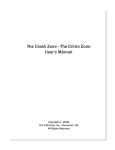
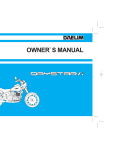
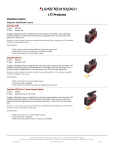
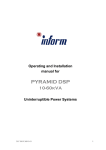

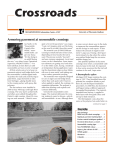
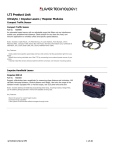
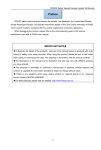


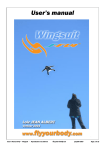
![[ENG] EVO DSP TM 10-30 kVA User Manual v. 2.0](http://vs1.manualzilla.com/store/data/005715238_1-26b73917878f712f842422018d03a475-150x150.png)




